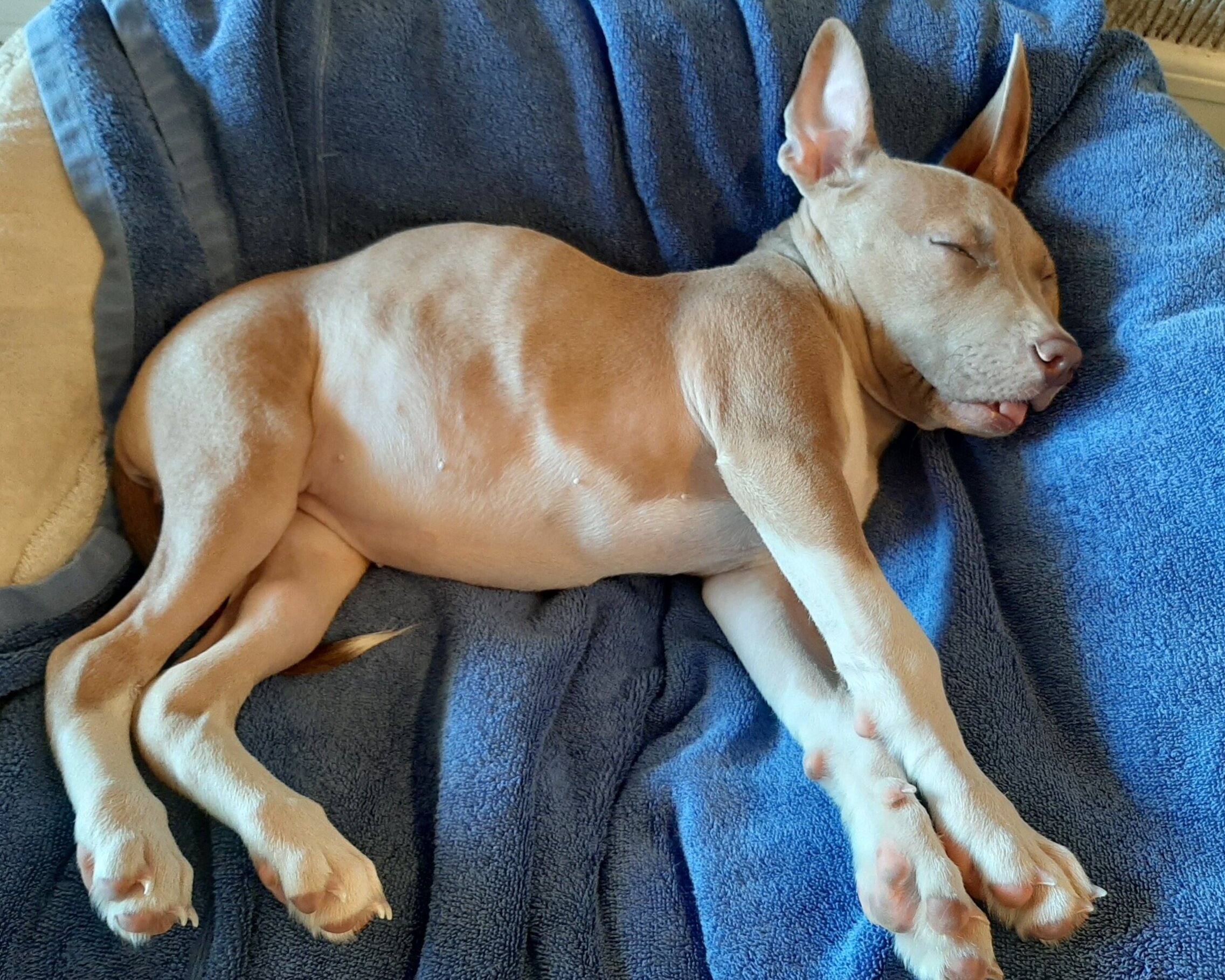Nutritional bone disorder: How Sophie the Wonder Dog inspired us all
Sure, Simon Veterinary Surgical specializes in orthopedic surgeries, but what is there to do if the patient’s orthopedic issues stem from a nutritional imbalance that cannot be surgically fixed?
On occasion, we’ve had patients come to us that are limping or unable to walk, with bowed legs that are painful to touch, or in severe cases, ataxic – meaning to lose control of most body functions. On closer examination, Dr. Simon can feel that their bones are soft, spongy, and too weak to hold the weight of their bodies. Though some soft bone disorders are genetically inherited, the most common source in these issues comes from a nutritional imbalance or deficiency, also known as rickets.
What nutrients are needed for healthy bone development?
Before we get into the nitty gritty of nutritional bone disorder and how it is treated, let’s take a moment to cover the key nutrients in the bone formation process:
Calcium & Phosphorus are nutrients that are primality obtained from the diet. Bone-forming cells use them to create calcium phosphate crystals and lay them in an organized fibrous matrix to construct the bone. A each life stage, a different Ca:P ratio is required for growth and maintenance.
Vitamin D can be obtained from the diet or from exposure to sunlight. Though not generally present in bones themselves, vitamin D is responsible for the absorption of calcium and phosphorus. Along with the parathyroid hormone, it also helps regulate calcium and phosphorus concentrations.
CASE STUDY: Sophie the Wonder Dog
When 3-month-old Sofie was brought to Dr. Simon, her hind legs were small, irregularly shaped, and could bend almost like noodles. She couldn’t stand or move on her own (ataxic), but it was clear that she still had feeling in her legs and desired to get up. Other veterinarians were not able to diagnose her condition and recommended euthanasia.
Unhappy with this recommendation, Sophie’s owners brought her to Simon Veterinary Surgical. In keeping with the SVS philosophy, Dr. Simon was happy to take on Sophie’s complicated case and investigate it further.
How does Dr. Simon determine if there is a nutritional bone disorder?
Determining if the weak bones are a result of a nutritional bone disorder takes a multi-pronged approach; rather than relying on just one method, Dr. Simon will assess the condition in various ways.
Assess the diet. Dr. Simon’s first step is to discuss the pet’s diet with their owner. Nearly all pet foods on the market include the essential vitamins and minerals needed to grow healthy bones, but if the owners opt to prepare the diet themselves, for example by feeding an all-meat diet, then some essential nutrients might be missing.
Examine the x-rays. Dr. Simon can further assess a nutritional imbalance by looking at the bones on an x-ray. Bones with abnormal mineralization have several distinctive characteristics, such as a bowing, lower radiograph opacity, incomplete fractures, irregular growth plates, microscopic lesions, and enlarged joints.
Run a blood test. The final step is to confirm that one or several key bone forming nutrients is out of balance. A serum blood test will typically show at least one or more of the following:
A low concentration of calcium
A low concentration of phosphorus
A low concentration of vitamin D
CASE STUDY: Sophie the Wonder Dog
Diet. After a discussion with the owners, Dr. Simon learned that Sophie had a bout of diarrhea when she was young. Sophie’s veterinarian at the time recommended a bland diet of chicken and rice. Not knowing that this new diet was only meant to be temporary, Sophie’s owners kept her on the diet for several weeks and this is when they noticed Sophie starting to decline.
X-rays. When looking at Sophie’s hind legs under an x-ray, Dr. Simon could see all the characteristic signs of nutritional bone disorder. In particular, her bones showed a very low opacity, indicating low calcium phosphate mineralization.
Blood test. Sophie’s blood test indeed showed that she was deficient in calcium, causing her Ca:P ratio to be out of balance.
After assessing these three areas, Dr. Simon diagnosed Sophie with nutritional bone disorder and started developing an individualized treatment plan.
How does Dr. Simon treat a nutrition bone disorder?
No matter which nutrient, or combination of nutrients, is out of balance, Dr. Simon will recommend a similar treatment plan, focused on increasing all key bone-forming nutrients. She does this in several ways by making sure the patient:
Is on a high-quality diet to ensure they are receiving a proper balance of nutrients.
Spends more time in the sunlight to increase vitamin D levels and help with the absorption and regulation of the other key nutrients.
Is started on BONEO Canine® Clinical Formula, a supplement exclusively available through veterinarians. In addition to containing the nutrients needed to grow and maintain healthy bones, this supplement contains a maximum strength patented protein-based technology that enhances nutrient absorption. BONEO Canine® is the only bone supplement on the market that promotes bone growth for the entire skeletal system, which is especially important for pets with nutritional bone disorders.
When animals put weight on the bones, it signals the bone-forming cells to get to work, so gradually introducing play and exercise will also help in the recovery process. However, this part of the treatment plan must be introduced very carefully since the bones can be quite fragile in the beginning.
CASE STUDY: Sophie the Wonder Dog
Sophie was a severe case requiring around the clock attention. Though not normal practice, Dr. Simon took Sophie into her custody to provide intensive treatment and monitor her progress. Sophie’s treatment plan included:
Hind leg casts for the first week to prevent further bowing and encourage the bones to develop in their natural shape
A high-quality, well-balanced puppy food diet
Daily BONEO Canine® Clinical Formula supplement
At least 1 hour of sunlight per day
Gradually introduced assisted standing and balance exercises
What is the prognosis for the patient?
Once the dietary nutrients are brought into balance, patients typically build back stronger bones within 3 months. With the help of BONEO Canine® Clinical Formula, we usually see an even shorter recovery time. There is a chance that the deformities that developed prior to treatment may persist for the rest of the patient’s life, however, if the patient is young enough, these deformities may correct themselves as the patient grows. If they continue on a balanced diet, the condition is unlikely to develop again and the owners can expect to see their furry friends live a full, healthy, energetic life.
CASE STUDY: Sophie the Wonder Dog
Under Dr. Simon’s care, Sophie quickly grew stronger and stronger. After 3 weeks of intensive treatment, she hit a milestone by walking, unassisted, in a full circle around a coffee table. After that, there was no stopping her.
On week 5, Sophie was returned to her owners in an emotionally joyful reunion. Sophie’s treatment continued under their care and after 3 months Sophie was running and playing. She began to grow out of her bowleggedness and by 6 months, at her spay, she was looking like a normal healthy pup with straight legs.
CASE STUDY: Sophie the Wonder Dog
The SVS team has since monitored Sophie’s progress and are happy to report that she continues to be a healthy pup under the care of her devoted owners.
Sophie came to us in October 2020, during the thick of a seemingly never-ending pandemic. Watching her tenacious journey was the happy success story we all needed. In helping her, she helped us - and thus, she became “Sophie the Wonder Dog.”
If you suspect you pet has a nutritional bone disorder or if you are interested in learning more about BONEO Canine® Clinical Formula, give Simon Veterinary Surgical a call today!












